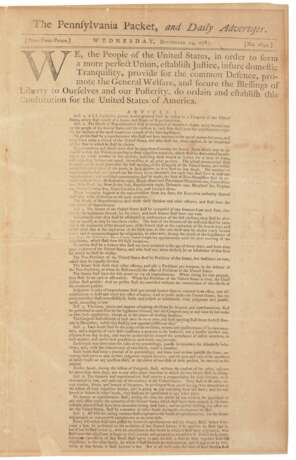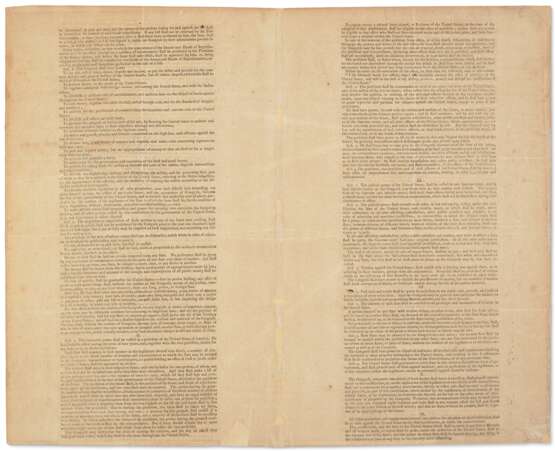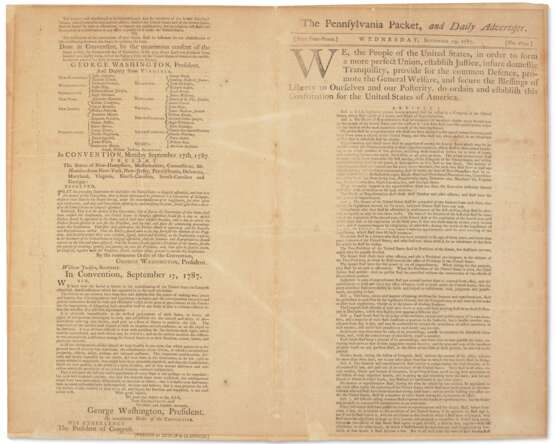ID 517697
Los 51 | The First Public Printing of the United States of Constitution
Schätzwert
$ 120 000 – 180 000
The First Public Printing of the United States Constitution, printed by the official printers to the Constitutional Convention. The first copy to appear at auction in 16 years. A momentous issue of Dunlap & Claypoole's Pennsylvania Packet, in which the full text of the new Constitution—today the oldest continuing charter of government in the world—was first presented to the public. This printing is preceded only by Dunlap & Claypoole's two draft printings (for the Committee of Detail and the Committee of Style) intended solely for the use of delegates during the Convention, and by their "official" edition of the final text, which was printed for submission to Congress (Evans 20818).
In the afternoon of 17 September, after Washington (President and delegate) and the Convention's 38 delegates had signed the engrossed Constitution, drafted a letter forwarding it to Congress and unanimously agreed the accompanying resolution submitting it to the state legislatures for ratification, they thankfully adjourned. When their pledge of secrecy to the Convention expired (with the public reading of the Constitution in the Pennsylvania General Assembly at about 11 a.m., 18 September), Dunlap and Claypoole, official printers to the Convention and proprietors of the Pennsylvania Packet, immediately prepared "a special issue, dated 19 September 1787, of the Packet containing the full text of all three documents. This issue is the first newspaper printing of the Constitution. Newspapers throughout the United States soon printed the Constitution and its accompanying documents in special issues, handbills and pamphlets. Within the month, the Constitution even crossed the ocean, appearing in the London Morning Chronicle and in the Annual Register..." (Richard B. Bernstein, Are We to Be A Nation?, 1987, p.186).
The dissemination of the Constitution in newspapers is of considerable interest and importance as it was in this form that most Americans became familiar with the new form of government proposed by the Convention. One careful researcher, Leonard Rapport of the National Archives, has identified four Philadelphia newspapers which also carried the text of the Constitution on the same day (this was, after all, news of the highest importance ("Printing the Constitution: The Convention and Newspaper Imprints, August-November 1787," in Prologue: Journal of the National Archives, vol.2, no.2. pp. 69-90). Despite these competing issues printed the same day, the Pennsylvania Packet printing would still—as has long been the case—be accorded primacy, for two principal reasons. Firstly, the Packet was printed by John Dunlap and David C. Claypoole, official printers to the Convention itself. Together as partners, or separately (Claypoole may originally have been a junior partner), they had printed nearly everything issued by Congress since 1775, including the 1776 Declaration of Independence. Secondly, with the exception of the Constitution's six-line preamble ("We the people..."), the text is entirely printed from exactly the same setting of type used for the official Congressional printing. As Rapport notes, the 5000 words of the Constitution represented "nearly one man-day of composition time" for the printer, so, sensibly, to make use of the wider margins of the Packet's larger sheets, they reset the preamble in large type, with a large capital "W," below the masthead and simply reimposed the rest of their standing type to fit onto the paper's four larger-size pages. The case might be summed up by emphasizing that the present Pennsylvania Packet text of the Constitution was struck from the identical setting of lead type that had printed the sheets of the official Congressional printing, sheets that Jacob Shallus, calligrapher, used when he copied onto parchment the engrossed document to which the delegates signed their names.
"By October 6, only twenty days after the Federal Convention, at least fifty-five of the approximately eighty newspapers of the period had printed the...Constitution" (Rapport,Printing the Constitution, p.89). With the text of the Constitution before the people, thanks to a free press, the great debate on its ratification would begin, a debate which continued until ratification by the original 13 states was completed (in 1791), and culminated in 1792, by the adoption of the Bill of Rights. Despite the tremendous changes, since 1787, in the nation and the people governed by the Constitution, Bernstein meaningfully notes, "the evolution of American politics and society continues to be shaped by the Constitution and by the principles and doctrines built into it by the men who drafted it. That the Constitution has worked as well as it has is a tribute to its flexibility and to the foresight of those who created it. That it may still be defective or capable of improvement is a challenge to us to equal the courage, imagination, and versatility of the Revolutionary generation of Americans" (Are We To Be A Nation?, p.272). Brigham 2:942; Evans 20819; Howes C713. Provenance: originally part of a bound volume of the Pennsylvania Packet deaccesioned by an unknown library in Washington, D.C. – purchased privately by the family of the consignor in the late 1970s in Charleston, S.C.
Four pages, folio (465 x 293mm). (Loss along lower margin affecting several words of text including part of the final line of page three and the printer's credit on page four, loss at lower left corner of page one not affecting text, all of which have been repaired with period paper and text replicated where necessary, some toning from light exposure and several spots of foxing, slight mat burn along top and right margins of page one.)
| Adresse der Versteigerung |
CHRISTIE'S 20 Rockefeller Plaza 10020 New York Vereinigten Staaten | ||||||||||||||
|---|---|---|---|---|---|---|---|---|---|---|---|---|---|---|---|
| Vorschau |
| ||||||||||||||
| Telefon | +1 212 636 2000 | ||||||||||||||
| Fax | +1 212 636 4930 | ||||||||||||||
| Nutzungsbedingungen | Nutzungsbedingungen | ||||||||||||||
| Versand |
Postdienst Kurierdienst Selbstabholung | ||||||||||||||
| Zahlungsarten |
Banküberweisung | ||||||||||||||
| Geschäftszeiten | Geschäftszeiten
|





